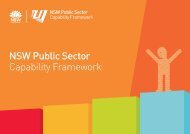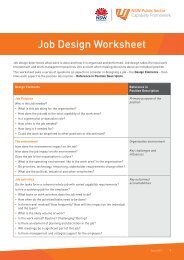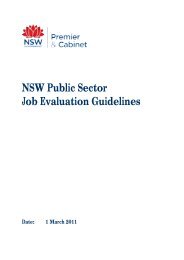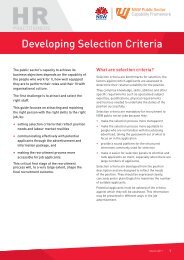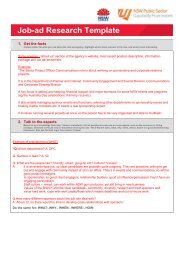Job Design & Description - NSW Public Sector Capability Framework
Job Design & Description - NSW Public Sector Capability Framework
Job Design & Description - NSW Public Sector Capability Framework
You also want an ePaper? Increase the reach of your titles
YUMPU automatically turns print PDFs into web optimized ePapers that Google loves.
HRPractitioners<strong>Job</strong> <strong>Design</strong> & <strong>Description</strong>The first step to getting the right person withthe right skills into the right job is to get thejob right. This guide helps human resourcepractitioners to design and describe a job to befilled or to support managers to undertake theprocess themselves.The principles contained in this guide applyto positions at all levels including executivepositions. However, position description formatsand the way in which capabilities are describedmay need to vary for different groups.What is job design?<strong>Job</strong> design determines the way work is organised andperformed. The process identifies:• the work to be done• how the job will be done• the skills, knowledge and abilities (capabilities)needed to do the job• how the job contributes to achieving organisationalgoals.It also considers the total work environment and workmanagement practices.Why job design is importantGood job design increases the value of the positionto the organisation, engages the worker and reducesindividual and organisational risk. It leads to greaterorganisational effectiveness and efficiency and betterresults from employees. Key benefits include:Organisational benefitsIncreased productivity and efficiency.Less need for close staff supervision, checking andcontrolMore effective work teamsA skilled, flexible, responsive workforce able to meetwork requirementsTargeted training to maximise value from traininginvestmentImproved talent management and succession planningSafer and healthier workplaceImproved employee attraction, engagement andretentionEmployee benefitsGreater clarity of work role, purpose andaccountabilitiesShared understanding of work expectations withsupervisorGood team cohesion as roles, relationships andresources are clearly definedVaried work and challenges, opportunity to developwork skills, flexibility and experienceTargeted training to meet current and future job needsBetter career pathways and developmentalopportunitiesSafer and healthier workplaceSupport for work/life balanceIncreased job satisfaction and engagementApril 2011 1
Where job design counts mostWell designed and clearly defined job roles are criticalfor successful:• <strong>Job</strong> evaluationThe information is needed for job evaluation.• Recruitment and selectionThe process helps:– selection panels to identify the jobrequirements (selection criteria), write the jobadvertisement, develop interview questions,and assess the best applicant for the job– potential job applicants to decide if theyshould apply for the job and to prepare forselection processes.• Career planning and developmentThe information helps staff to understand therequirements of their role, gain insight into therequirements of other roles in the organisation andidentify the capabilities needed for their chosencareer paths.• Performance managementClearly defined roles allow managers andstaff to develop shared understanding of workperformance expectations. <strong>Capability</strong> benchmarkshelp them identify and meet their professionaldevelopment needs.• Reward and recognitionClearly defined capability benchmarks make iteasier to recognise work performance which isabove expectations.• Workforce planningWhen aggregated, individual position capabilityrequirements should meet business/organisationalcapability needs.• Work allocation planningManagers can ensure that the work supportsthe organisation’s core business and is correctlyallocated.• Training investmentIndividual and organisational training are bettertargeted.• Ensuring workforce safetyThe information may help identify hazardousconditions, unhealthy environments or unsafe workpractices/processes which need to be addressed.It may also be used to identify return to worksolutions as part of a rehabilitation plan.• Workforce equity and diversityThe process may also identify ways of improvingworkforce equity.When job design is needed<strong>Job</strong> design is needed when:• there is significant change to organisationalpriorities, objectives, structure or operations• individual roles change• new technology is used for the work• work needs to be reorganised to achieveoperational efficiencies• job vacancies occur• improved work practices need to be implemented• new positions are created• new functions are taken on by the business unit• managers and staff discuss job performance andfuture directions of the positionWhen job design is not the solution<strong>Job</strong> design is not the answer to all workforcechallenges. Issues like work location, intrinsicallyboring repetitious tasks and sub-standardperformance may need other solutions.Some management options to consider are:• job rotation to give staff a more varied workexperience• introducing flexible work arrangements• strong team arrangements to provide peer supportto individuals• creating a pleasant work environment by providinggood employee facilities and encouraging teamactivities• managing poor performance• providing training opportunities for careerdevelopment• exploring alternative system or innovativetechnology solutions.April 2011 2
Steps in job design and descriptionThere are three key phases in developing anddescribing a job:1. Organisational designThis phase determines the organisation’s functionsand structure.2. <strong>Job</strong> designThis defines the primary function, accountabilitiesand operational arrangements of the job.3. <strong>Job</strong> analysisIn this phase, information about the job isgathered, analysed and documented. Training injob analysis for the organisation’s accredited jobevaluation system is valuable for this process.Managers can contribute to each phase asthey have in-depth knowledge of the job and itscontribution to business or organisational needs.Organisations may implement the three phasesindependently or in various combinations.They may use internal or external specialists orthe organisation’s business unit managers.These guidelines focus on job design and jobanalysis and should be applied in conjunctionwith the organisation’s business rules for theseprocesses.Steps which are common to the job designerand the job analyst are described only once.Specialist job analysts should skip the <strong>Job</strong> <strong>Design</strong>Decisions step.<strong>Job</strong> <strong>Design</strong> and <strong>Job</strong> Analysis – Specialised Process ModelOrganisational objectives / planOrganisational structure<strong>Job</strong> <strong>Design</strong> Processes<strong>Job</strong> Analysis ProcessesSTEP1Gather informationon the position(written, net, interviews)Gather informationon the position(written, net, interviews)STEP1STEP2Analyse the informationAnalyse the informationSTEP2STEP3Make job design decisionsDraft the job descriptionSTEP3STEP4Refer to <strong>Job</strong> Analyst fordevelopment of positiondescriptionReview & finalise positiondescription (with manager& subject experts)STEP4STEP5Review & approve positiondescription (with job analyst& subject experts)Human Resource ManagementFunctions<strong>Job</strong> evaluationGrade & classification decisionsApril 2011 3
<strong>Job</strong> <strong>Design</strong> and <strong>Job</strong> Analysis – Combined Process ModelOrganisational objectives / planOrganisational structureSTEP1Gather informationon the position(written, net, interviews)STEP2Analyse the informationSTEP3Make job design decisionsSTEP4Draft the job descriptionSTEP5Review & finalise positiondescription (with manager& subject experts)Human ResourceManagement Functions<strong>Job</strong> evaluationGrade & classification decisionsApril 2011 4
The steps in detailStep 1: Gather information on the jobResearch the information needed to design anddescribe the job. Positions in new or changing areasusually require more research than existing jobs thatare satisfactorily meeting organisational needs.Sources of relevant information include:• organisational information (organisation charts,corporate and business plans, annual reports,structural or performance review reports)• job questionnaires completed by current/formerposition occupants or managers. These are usefulfor unique positions that are documented for thefirst time or when developing generic positiondescriptions, as they provide a full picture ofcurrent work activity.• existing position descriptions for the job or similarjobs, including generic position descriptions.<strong>Job</strong>site searches (including jobs.nsw.gov.au) andthe <strong>Capability</strong> <strong>Framework</strong> position descriptionlibrary (www.pscapabilities.nsw.gov.au) are usefulsources for position descriptions.• having the position occupant keep a diary of taskscarried out over a defined period.• samples of work undertaken by the occupant or bysomeone in a similar role.• industry/professional association websites• subject experts in the field of work• industrial award classifications and descriptors• a functional review of the area (this may be asignificant task)• job analysis interviews with position occupants.<strong>Job</strong> analysis interviewsTalking to the position occupant gives the job analystthe opportunity to gain deeper understanding ofthe job and to clarify any gaps, inconsistencies orobscurities in the information gathered to date.The current position occupant should be interviewedabout the job, except in special circumstances, suchas a temporary appointee not being fully familiar withthe position.<strong>Job</strong> analysis training manuals provide useful guideson interviewingTips for interviewing• be prepared. Know the material and the areasyou need to address• allow plenty of time (60-90 minutes) and booka quiet place for the interview• aim for a non-threatening, neutralatmosphere by explaining the purpose of theinterview, answering any questions• listen to the incumbent. Ask questions, ask forexamples, and check your understanding ofthe job with the incumbent. Assume nothingabout the job!• watch for bias• do not express judgments of the job/worksituation• keep the focus of the discussion on theposition rather than the incumbent, especiallywhen it comes to capability requirements• keep notes as the interview progressesStep 2: Analyse the informationFocus on the actual requirements of the job and siftthrough the information provided, identifying areas forclarification or expansion.Tips for analysisBe alert for...• under-reporting of accountabilities, decisionmakingand challenges, perhaps becausethese are ‘routine’ to the occupant• overstatement of job accountabilities andcapability requirements, perhaps to influencethe grade of the job or because these reflectthe occupant’s own capabilities.• skewing of jobs by the skills and interestsof current/past incumbents, rather than byorganisational requirements• impact of changes over time• changes required to support organisationalchange or proposed new directions• statements which have a heavier focus on howthe job is done rather than what is done in thejob.• bias from the incumbent, their manager and/or the job analyst. This may affect each step ofthe job analysis process.April 2011 5
Step 3: <strong>Job</strong> design decisionsThink through and then make decisions on:• the key elements of the job. These includeits purpose, work accountabilities, reportingrelationships, working interrelationships, authoritylimits and capability requirements.• any necessary changes to other jobs in the team orunit to address risks, vary work activities, fill gapsor reduce duplication.Use the <strong>Job</strong> <strong>Design</strong> Worksheet to check criticaldesign elements.Step 4: Write the position descriptionDescribe the critical elements of the job using theDepartment/Agency’s standard format.A model position description template has beendeveloped for the public sector, together with anonline tool to facilitate writing the job description (seewww.pscapabilities.nsw.gov.au).Departments/agencies may vary the sector model,providing that their template• captures all information necessary for evaluationof the position• maps skills, knowledge and abilities required forcompetent performance of the position from the<strong>Public</strong> <strong>Sector</strong> <strong>Capability</strong> <strong>Framework</strong> (PSCF).For example, some organisations:• make the organisation environment statement astandard attachment• include selection criteria (if included, a maximumof six is suggested)• have developed narrative descriptions for eachcapability level that they include in the PD• attach values statementsThe online tool generates a position description inWord that can then be edited.The model template for the sector contains detailedguidelines for writing the position description. Somegeneral principles follow:Tips for writing position descriptions• Keep the position description succinct(preferably 2-3 pages plus organisation chart).Longer position descriptions may providemore information but tend to be repetitious• Use plain English. Keep the language simple,sentences short, and paragraphs limited tosingle statements• Avoid jargon, acronyms or terms only‘insiders’ can understand• Write in the third person and in ‘activevoice’. For example, ‘Approves routineleave applications and refers special casesto the Human Resources Manager withrecommendations for decision’• Use gender free language• Ensure internal consistency. For example,capabilities and capability levels shouldclearly relate to the accountabilities describedfor the position• Take care with spelling, grammar, font andlayout. The final document should lookprofessional and be easy to read.• Remember, the position description isintended to document key accountabilitiesand capabilities, not to capture every activity/task performed and skill used.• Don’t just list tasks. Aggregate work activitiesinto accountability statements that explainwhat the job does, how and why.• Avoid vague and ambiguous terms, such as‘assists’, ‘transport duties’, and ‘advises’. Bespecific about what the job does.• Check with the position incumbent ormanager if you need further clarification.• Follow your organisation’s guidelines forjob titles to ensure consistency across theorganisation.April 2011 6
• a sound basis for workforce managementprocesses, such as recruitment and selection,workforce planning, performance managementand developmentThe capability framework will impact on thecapabilities section of the position description. Thebehaviours described in the framework may also beuseful in developing the key accountabilities for theposition description.Agencies may develop capabilities to meet theirspecific needs, in consultation with the Department ofPremier and Cabinet.The capability framework will not replace:• job evaluation, which takes into account a broadrange of factors such as position scope, breadth,authority, challenges and budget as well ascapabilities required.• the need to write effective job advertisementsPosition descriptions focus on key capabilitiesneeded for competent performance of the job. <strong>Job</strong>advertisements focus on what is most important forentry into the position.<strong>Job</strong> advertisements should excite interest in the job.Position descriptions are a human resource managementdocument – they may be useful for job applicantsbut they are not designed as a recruitment tool.Using the capability frameworkposition description libraryThe library contains generic position descriptionsdeveloped for jobs that are common in the publicsector. These have indicative evaluation profilesagreed to by a joint Department of Premier andCabinet – <strong>Public</strong> Service Association job evaluationpanel. The number of position descriptions in thelibrary will be added to over time.The library is a resource for agencies. The genericdescriptions may be adapted to agency needs.Their evaluation profiles may be accepted if theyare adopted without change to the purpose,accountabilities and capabilities. However, it isrecommended that the evaluation profile be checkedfor consistency in the organisational context becausefactors important in assessing the work value of aposition (such as budgets, reporting structures anddecision authority) are context-specific.For example, the Office Manager’s accountabilities andchallenges may sound right for most organisations.But the actual job may be larger in a big, complexorganisation, with multiple units, more clientsrequiring services, larger budgets and more staff tosupervise. Alternatively, its delegations may be higherand scope of decision-making greater in a smallerorganisation with a flat management structure.These are just two of the possible combinationsof context-specific factors that would influenceevaluation of the Office Manager position.Agencies are not obliged to use the positiondescriptions from capability framework positiondescription library, but are encouraged to developgeneric position descriptions for each grade oftheir most common jobs, rather than developing aunique description for every individual position in theorganisation. This approach achieves efficiencies,simplifies mobility and improves grading consistency,even if the agency permits some customisation of itsgeneric position descriptions to fit specific roles.Supporting publications and tools<strong>Public</strong>ations• <strong>Job</strong> design & description guide for managers• <strong>Job</strong> analysis questionnaire• <strong>Job</strong> design worksheet• Steps in mapping capabilities• Position description quality checklistTools• Position description builder, an online toolto help line managers to develop effectiveposition descriptions. The tool steps thewriter through the process of developinga position description, and on completiongenerates a position description using ageneric position template in MSWord.• Position description template and guide• Library of generic position descriptions• <strong>Capability</strong> card setAll supporting publications and tools areavailable at www.pscapabilities.nsw.gov.au/hrmanagers/tools-and-resources/Copyright © 2011 Department of Premier and CabinetThe Department has no objection to this document being copied, in whole or in part, provided there is due acknowledgement of any material quoted from it.<strong>Public</strong> <strong>Sector</strong> Workforce | Department of Premier and CabinetT: (02) 9228 4444 | F: (02) 9228 3522 | E: workforceplanning@dpc.nsw.gov.au | W: www.pscapabilities.nsw.gov.auApril 2011 8





